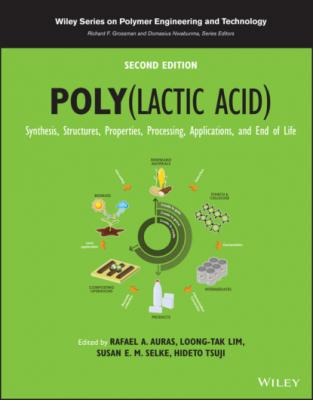Poly(lactic acid). Группа авторов
Чтение книги онлайн.
Читать онлайн книгу Poly(lactic acid) - Группа авторов страница 71

5.6 STEREOCOMPLEX PLA‐BASED COMPOSITES
Stereocomplexation has been used by researchers to impart heat stability to composites. In principle, when the desired properties cannot be achieved by a single component, the incorporation of several fillers may lead to the tailored/desired properties. Stereocomplexed PLA is known for its enhanced thermal resistance, which has been incorporated and modified with fillers such as hydroxyapatite, chitosan, cellulose, graphene, and so on to obtain materials with customized properties. To this end, Total Corbion PLA, a European joint venture company, has already started the development of glass fiber‐reinforced sc‐PLA as an engineering plastic for automotive, aerospace, electronics, home appliance, marine, and construction industries [83]. Sun et al. have grafted graphene oxide (GO) to PDLA by ROP of D‐lactide, where the OH groups on the GO acted as initiator [79]. The grafted PDLA was then blended with PLLA in solution for casting of sc nanocomposite films. The activation energy of crystallization was lowered along with an increased fraction of sc crystallites and improved crystallinity of the nanocomposites, as compared with the PLLA/PDLA blends without the GO filler. This effect may be attributed to the heterogeneous nucleation of GO. The cold crystallization, however, led to lower crystallinity, possibly due to the reduced chain mobility and hindered crystal growth resulting from the exfoliated GO sheets.
Furthermore, Gupta et al. have demonstrated the use of nano‐amphiphilic chitosan to develop highly heat stable sc‐PLA [80]. The grafting of chitosan to the oligomeric PLLA was done via in situ polycondensation of L‐lactic acid to synthesize nano‐amphiphilic chitosan. The PLLA‐modified chitosan (0.5–1.5%) along with PLLA/PDLA (50/50) was melt blended using extrusion followed by injection moulding to form dumbbell sc nanocomposite specimens. Heat treatment (annealing above 160°C) led to the exclusive formation of sc crystals with ~40% crystallinity. Also, cooling the nanocomposite from the melt at 2°C/min increased the crystallinity to ~70% with an exclusive formation of sc crystals. The heat distortion temperature was elevated from 70(sc‐PLA) to 145°C for the sc nanocomposite containing 1.5% filler. In another study, the use of nano‐amphiphilic chitosan (1–3%) in the blends of PLLA/PDLA (50/50) has been demonstrated [20]. The filler was mixed with equal amounts of PLLA and PDLA and mixed by stirring followed by solvent casting into films. The solvent (chloroform) was allowed to evaporate at room temperature for 24 h followed by drying under vacuum at 50°C for 24 h and then annealing at 120°C for 2 h. The sc crystallites were formed in the nanocomposites with a ~56% crystallinity, where the degree of stereocomplexation became higher upon melt cooling as compared with annealing the blend film of PLLA/PDLA (control). The nanocomposite films showed ~56% reduction in the oxygen permeability as compared with the blend film of PLLA/PDLA (control). The addition of the nanofiller also led to an increase in hydrophobicity of the nanocomposite, which was attributed to the increased surface roughness, as well as crystallinity. The viability of fibroblast cells (BHK‐21) on the surface of the nanocomposites have been determined, manifesting the biocompatible behavior of the composite materials.
In another study, the biocomposites of sc‐PLA were prepared by employing cellulose microcrystals (CMC) as a filler (1–10%). The ROP technique was used to develop PDLA‐grafted CMC, which was mixed with PLLA at 50/50 ratio and melt extruded, followed by injection moulding to prepare the biocomposite specimens. The improved dispersion of CMC led to the formation of sc crystallites and suppressed the homo‐crystallite formation. This CMC/sc‐PLA biocomposites resulted in significant improvement of the tensile strength (~96%) as compared with sc‐PLA along with a high storage modulus (~3500 Pa). The enhanced sc formation and the incorporation of CMC reduced the permeability of oxygen and water vapor, suggesting its potential for engineering and packaging applications [81].
The use of nano‐hydroxyapatite (n‐HAP) has drawn enormous attention in the biomedical field because hard bio‐tissues such as human bones and teeth are composed of n‐HAP. In order to exploit sc‐PLA and n‐HAP for biomedical applications, their biocomposites were prepared in a study by Gupta et al.; the n‐HAP was grafted to PDLA via in situ ROP where the OH groups on n‐HAP acted as initiating species. The grafting was confirmed by 13C NMR and thermogravimetric analysis [82]. The grafted PDLA was blended with PLLA to develop sc biocomposites, which gave the exclusive formation of sc crystallites due to the improved dispersion of n‐HAP and extended molecular surface area provided by the PDLA chains. The nanocomposites exhibited improved mechanical properties (~40 MPa in strength, ~132% elongation at break, and ~47% increase in storage modulus). The increase in crystallinity resulted in improved resistance to moisture, as well. The viability of BHK‐21 cells on the nanocomposites revealed their applicability as a biomaterial.
FIGURE 5.5 Applications of the sc‐PLA‐based copolymers and composites.
These findings show that sc‐PLA‐based copolymers and composites are promising for addressing polymer processing and application concerns in the packaging and biomedical domains. The applications of sc‐PLA‐based copolymers and composites are shown in Figure 5.5.
5.7 Advances in Stereocomplex‐PLA
Several processing techniques such as electrospinning [29, 84] and melt spinning [85] have gained enormous recognition for developing sc‐PLA fibers with improved stereocomplexation [86–88). Often, targeted biomedical applications require a controlled hierarchy, which may be possible by selectively modifying the surface of nanofibers [89]. One such method reported by Xie et al. is the combined use of electrospinning and a controlled polymerization technique for designing PLA nanofiber shish kebabs. The sc‐PLA nanofibers produced by electrospinning are used as the shish where the secondary polymer (hc‐PLA or sc‐PLA) is decorated to form a kebab lamella. The soft epitaxy mechanism possibly leads to the formation of shish kebab structures where the sc‐PLA nanofibers (shish) serve as the nucleating sites for kebab lamellae [25]. Such controlled mechanisms are of substantial importance when functionalizing the surface of nanofibers required for intended applications. Furthermore,